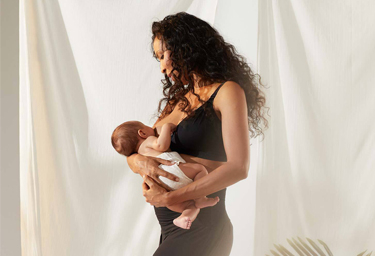As every baby is different, every birth is different as is every woman’s breastfeeding journey. Your body has made the baby and that’s only half the job, the other is to feed and nourish them to help them grow and your breast milk is the best formula for that. Breastfeeding is not easy for some women, so here are some tips to help you out.
We’ve all heard that ‘breast is best’ but what does this actually mean.
Why Breastfeed
Economically and Environmentally: You don’t have to buy formula, bottles, detergent, hot water, sterilizer etc.
Mentally: Research says that a breast fed baby is more likely to be smarter than those that don’t and will also develop motor skills quicker than others that aren’t breast fed.
Allergically: Studies show breast fed babies are less likely to develop allergies.
Specifically: Your baby is born from you. Your body knows and concocts the perfect breast milk for your baby specifically for their needs. This is dependent on their age, growth, thirst, heat, nourishment and throughout illness too.
Medically: Breastfed babies are less likely to develop earaches and infections, stomach viruses, asthma, the flu and diabetes.
Personally: Breastfeeding is the best and quickest way to get you back into shape. A lot of women don’t know this but breastfeeding is a natural birth control as your period doesn’t usually come back for at least 6 months. Breastfeeding contracts your uterus.
Breastfeeding uses up an extra 300 – 500 calories a day, and that’s just by sitting there.

When Breastfeeding is Hard
With most of a woman’s attention focused on her pregnancy and pending birth, breastfeeding is often overlooked initially.
We assume that it will come naturally and that mother and baby will get into a routine.
This is not always the case, and most new mums will experience initial difficulties especially with their first child.
Why Breastfeeding can be hard:
Lack of knowledge
Spending little time researching or attending breastfeeding classes can contribute to a difficult start.
A basic understanding of breastfeeding positions and a good latch will help steer you along the right path.
First time
Trying something for the first time is not always easy. A lack of experience and understanding of the procedures can result in mistakes being made and can lead to frustration.
Latch
It is extremely important to get the latch right. If a baby is not latching onto the breast correctly he will not feed effectively and can damage your nipple. Cracked nipples if not cared for probably can become infected and very sore.
TIP: Air-dry cracked nipples after a feed. Express a small amount of breast milk after the feed the rub into the nipple. This will help to heal and soothe. A Lanolin cream can also be used.
Pain
Breastfeeding can be painful to start with. This is because the breasts become engorged with an oversupply of milk, the milk ducts can become blocked; the let down and nipples can become cracked.
It is important to remember that this does not last forever, and the discomfort will pass in a matter of a few weeks as the body learns to regulate its milk supply and your nipples harden.
TIP: Invest in a good quality seamless bra. It will not only provide you with good levels of support, but also will stretch and grow with your changing body without restriction.
Doesn’t come naturally
Breastfeeding does not always come naturally to everyone. Some of us have to work at it much more than others. Stick with it because with practice it will become easier.
Unrealistic expectations
Avoid comparing yourself with others. Your breastfeeding journey is your own. Be patient with yourself and your baby.
Wardrobe
Wearing a good supportive nursing bra is essential to breastfeeding success. Not only will it provide that much needed comfort and lift your breasts will require but it will also provide you with easy access for feeding.
TIP: Consider wearing outerwear that makes access easier too. Shirts with buttons, clips or zips are wonderful as access is less fussy. A large scarf is also a wonderful accessory that can be used as a cover up should you require one.
Leakage
Embarrassing leaks can occur if nursing pads are not worn or changed regularly.
Invest in good quality natural nursing pads that are easily washed for reuse. Cotton, hemp and bamboo fabrics are best as they will allow the nipple to breath and provide good levels of comfort and security.
TIP: Avoid disposable nursing pads if possible. They are made from man-made fibers that can lead to hot damp conditions and can encourage infection such as thrush.
Nervous
A lot of women over think it and become concerned with the quantity of milk their baby is drinking. Baby will feed when he is hungry.
To start he will be less efficient at feeding and may need to feed more often. After time he will become an expert and will get more milk per feed meaning he needs to feed less often.
YIP: Avoid the urge to top up feeds with formula. Regular health check ups will help to ensure your babies growth and progress is monitored.
Support
A lack of support can result in women unnecessarily giving up breastfeeding.
There are many wonderful support programs available in the community. Make contact with one early on to help ensure your breastfeeding journey is a successful one.
Tired
Lack of sleep early on can sway some women to pump milk and feed their baby via a bottle. Avoid doing this in the early days if possible. The latch required to feed from a bottle is very different to that on the breast. Giving a baby a bottle will only confuse him and can result in on-going difficulties with breastfeeding.

Breastfeeding in public
Breastfeeding in public is not a pleasant experience for all women as she may feel judged or looked upon unkindly by strangers.
Invest in nursing covers and or nursing tank tops to help make feeding in a public place more discrete.
Returning to work
Some women may feel as though they need to give up breastfeeding when they return back to work.
This is not actually necessary. Invest in a small portable breast pump to pump and store milk during the day while at work. This way baby can still receive his nutritious breast milk during the day via a bottle when cared for and mum can breastfeed him early morning and evenings when she is at home.
Why you should not give up
Breastfeeding is a beautiful gift given to us by nature. Not only does it make economic sense but it is nutritious and helps to support his growth and immune system. Breastfeeding also helps to encourage a strong bond and lasting love between mother and child.
A mother should only give up breastfeeding when both she and her baby decide. Resist the pressures by external forces and make the judgment yourself when to stop.
It is recommended to breastfeed for no less than 6 months. However many women do continue to breastfeed their children as toddlers.

What to do to prepare for breastfeeding:
1. Make sure your wardrobe is ready to breastfeed. Although you will probably not be breastfeeding in public straight off the bat, it’s a good idea to have clothing and underwear ready for the task, even if you are just at home.
Hot tip: Ask yourself a few questions like:
– Am I comfortable without using a cover cloth?
– Do I want an A-frame sling or a side sling bra?
– Am I ok with showing my belly or do I want my clothing to be top opening?
2. Practice with a doll or a pillow (or a friends baby – as long as they are not hungry) the grip and hold required to feed your baby. Everybody is different from arm lengths, torso lengths, baby lengths and overall preference for comfort. What works for someone may not work for you. Try it out first.
Hot tip: This could even be one of the games at your baby shower. The more you people you tell and get involved in your breastfeeding journey, the more comfortable they will be also.
3. Test out your bras. When your milk first comes in, your breasts may be sore and engorged.
Hot tip: This is not the first time you want to be trying to unlatch your nursing clip, so try it out first.
4. Watch a few videos on youtube to see what it looks like, close up, and understand a good latch and a bad latch.
5. Before you have your baby, your midwife may ask if your colostrum is being produced. To get the flow happening, you may need to squeeze some out by gently milking your breast – not your nipple. Another chance to watch some youtube for how this is done correctly and with what pressure.
Hot tip: Practice at home after a warm shower
Related: 9 Qualities You Should Look For In A Good Nursing Bra
6. Prepare a breastfeeding corner in your lounge, or a few of them around the house. You could adorn them with snacks, water bottles, phone charger, books, magazines, notebook and pen, pillows, comfortable chair and soft lighting.
7. Be ready for disappointment: It takes 6 weeks for your milk to establish so take heed if it does take this much time to master the art. It is not something that all women just know, for some it is a learned skill. If you are unable to breastfeed, don’t become disheartened or discouraged.
8. Become a student: If breastfeeding is a skill then you can be taught. Find a friend, relative, midwife or lactation consultant to guide you through.

How to breastfeed:
1. Immediately after birth, if you can have skin-to-skin contact and just enjoy each others company.
Hot tip: Skin-to-skin and heart-to-heart for as long as you can. Focus on your baby as this is your time.
Related: Essential Newborn Care
2. Bring your baby to your breast or let your baby come to your breast. Try not to bring your breast to your baby as this can result in bad habits forming. You may become uncomfortable very quickly and this can lead to muscle aches and pains and a stiff neck. Provide all the support you can for your baby so that their mouth is lined up with your nipple. Grab some pillows and move them around as much needed so that you stay as comfortable as possible.
Hot tip: Practice even when your baby is has been fed to achieve a comfortable position.
3. Support your baby’s body with a pillow or your arm. Make sure that you are comfortable if using your arm. If you keep their body and chin against your body, this is the best way to ensure a good latch. The first points of contact are to be the chin and bottom lip on your breast, not your nipple. The second point is the top lip on the other side of your breast, after a wide mouth latch for optimum sucking to ensure the nipple and most of the areola are encompassed by the baby’s mouth and throat. It can take a few goes with guesstimate timing, so be patient.
4. Once your baby is latched on, their chin should be buried into your breast and their nose free so they can breathe.
5. Your baby will start to suck with a few lighter sucks and then larger deeper sucks that you can see when they are actually swallowing. You may feel your milk be ‘let-down’ at this stage. This let-down feeling may also cause cramps in your uterus as breastfeeding helps your uterus contract after your baby is born.
6. Watch your baby not the clock. Take cues to find out when your baby is hungry and needs to be fed and also when they are full. They may start fidgeting, fall asleep, need to burp, be too hot or something completely different. You will soon learn to understand what your baby is trying to tell you. Try not to worry about your milk supply as the more your baby needs, the more you will make.
Hot Tip: Be confident and know that you are able to feed your baby. You have made them and this is also part of that. Enjoy this time as it doesn’t last forever.
How much and how often to breastfeed
It is advised to breastfeed baby as often as he wants. This is generally known as feeding on demand and is recommended by lactation consultants and health care providers.
Immediately after birth
It takes a few days for a woman’s breast milk to come in. The breast will initially produce a thick solution called Colostrum which is a powerful antibody designed to nourish and protect your newborn baby. It is considered to be their first immunization.
The Colostrum will gradually change to mature milk at about 2 to 5 days after giving birth. Mature milk does not contain the same concentrate of antibodies as Colostrum but does still contain them along with essential vitamins and minerals.
First few days
A newborn baby’s ability to effectively feed off the breast is not fine-tuned at this point, as he is learning to suckle and latch which does not always come easily.
An incorrect latch will hinder his ability to feed and will also cause damage to your nipple. Should you suspect that your baby’s latch is not correct, it is advised to see your health care provider and or lactation consultant immediately to help correct the technique.
The good news is that there are many different breastfeeding positions; sometimes it just takes us a little while to find one that works best for you and baby.
Newborn babies will take a long time to feed initially. They will often fall asleep at the breast. Stroke his check gently to help stimulate him and gently wake him from his sleep. This way you can be sure that he fills his belly and does not demand a feed immediately after.
A newborn baby will feed approximately 10 times within a 24-hour period. This is because his stomach is tiny and breast milk is easily digested. He will feel hungrier sooner, compared with a formula fed baby.
Weeks old
Your body will learn to regulate the milk supply needed by your baby. The more he drinks the more your body will produce.
He should by this time be fairly efficient at feeding off the breast. Feeding times should be shorter and less frequent. He is likely to be feeding every 2 to 4 hours compared with every 90 minutes as when he was first born.
As your baby continues to grow you may notice times when he wants to feed more often and for longer. It is likely that during these periods that he is experiencing growth spurts. This may last for up to a couple of weeks but will return back to normal in time.
Some women may start to question if their body is producing enough breast milk during this time. The best indicator is your baby’s weight gain. It is advised to take your baby for regular health care check ups to monitor his weight gain and development. This way you can put your mind at ease and focus on enjoying your new baby and watching him navigate his way through life.
Months
Just how long you decide to breastfeed is entirely up to you. It is however, recommended to breastfeed your baby for no less than 6 months.
Breast milk contains nutrients and antibodies, which help to aid in his growth and physical well being of your baby.
By this time your baby will have established a good latch and breastfeeding will be a joy. Not only is it a time for nourishing your baby, but a time to enjoy snuggles and bonding.
You will find that your baby will demand more than just milk eventually. Feeding him solids is a natural progression, however, breast milk is still essential to help ensure he stays hydrated, nourished and protected from sickness.
Breastfeeds will become less frequent as breast milk is no longer his main source of nourishment.
Your breasts will continue to produce just the right amount of milk as needed by your baby.

Need support?
There is no shame in asking for help.
Contact your local breastfeeding support groups for advice and support where needed.
They will assess your technique and help to correct any problems that might be occurring.
Continue with follow up visits until you feel confident you have mastered the technique.
—
Disclaimer: Cake does not provide medical advice, diagnosis, or treatment. Any information published on this website or by this brand is not intended as a substitute for medical advice, and you should not take any action before consulting with a healthcare professional.
LIKE WHAT YOU READ?
Join CakeMama Club & get 10% OFF your first order!
Plus you’ll get tips + tricks for pregnancy, postpartum & breastfeeding, get member-only offers, earn CakeCoins every time you shop + more. Learn more














































































































































